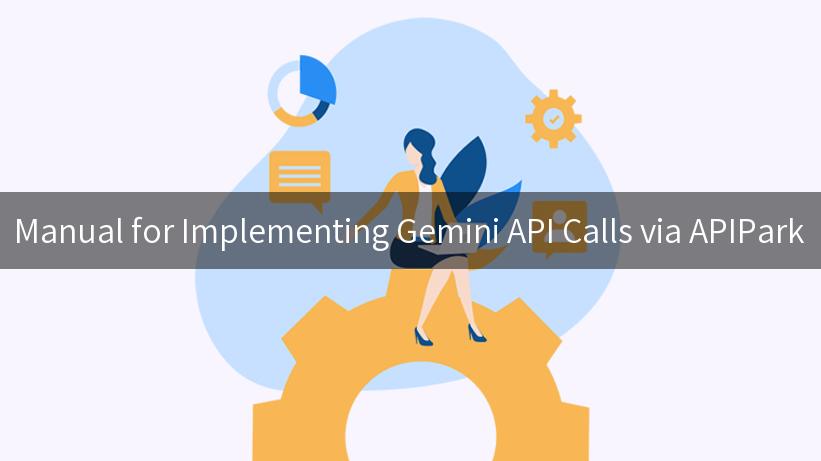
In the rapidly evolving landscape of enterprise technology, the integration of artificial intelligence (AI) into business processes is no longer an option but a necessity. The demand for efficient, secure, and scalable solutions is ever-growing, with businesses seeking to harness AI capabilities to drive innovation and growth. This manual provides a comprehensive guide on implementing Gemini API calls via APIPark, focusing on ensuring enterprise security when using AI, leveraging Amazon’s services, and utilizing API Gateway effectively.
Understanding Gemini API and APIPark
Before diving into the implementation details, it’s crucial to understand what Gemini API and APIPark offer. The Gemini API is a powerful tool that provides AI-driven insights and capabilities, which can be seamlessly integrated into enterprise applications. APIPark, on the other hand, is a platform that facilitates API management, offering features like monitoring, versioning, and security to ensure robust API operations.
The Importance of Enterprise Security in AI
Key Considerations
When integrating AI into enterprise operations, security should be a top priority. AI systems often handle sensitive data, and any breach could lead to significant repercussions, both legally and financially. Key considerations include:
- Data Encryption: Ensuring all data transmitted via the API is encrypted using industry-standard protocols.
- Access Control: Implementing stringent access controls to ensure only authorized personnel can access sensitive AI functionalities.
- Regular Audits: Conducting regular security audits to identify and mitigate potential vulnerabilities in the AI system.
Best Practices
To enhance enterprise security when using AI, businesses should adopt the following best practices:
- Implementing Multi-Factor Authentication (MFA): Adding an extra layer of security to authenticate users.
- Using API Keys: Protecting API endpoints by using unique API keys for each client.
- Monitoring and Logging: Continuously monitoring API calls and maintaining logs to detect any unusual activity.
Leveraging Amazon’s Services for AI Integration
Amazon offers a suite of services that can significantly enhance the integration of AI capabilities into enterprise systems. These services provide scalability, reliability, and security, making them ideal for enterprise applications.
Amazon API Gateway
Amazon API Gateway is a fully managed service that makes it easy for developers to create, publish, maintain, monitor, and secure APIs at any scale. It acts as a “front door” for applications to access data, business logic, or functionality from your backend services.
Benefits
- Scalability: Automatically adjusts the scale of API requests to meet demand.
- Security: Offers features like AWS Identity and Access Management (IAM) roles, resource policies, and custom authorizers to secure APIs.
- Monitoring: Provides detailed metrics on API usage and performance.
Using Amazon API Gateway with Gemini API
To implement Gemini API calls via Amazon API Gateway, follow these steps:
- Create an API in Amazon API Gateway: Set up a new API using the API Gateway console.
- Define Resources and Methods: Define the resources and methods that correspond to the Gemini API endpoints.
- Integrate with Lambda Functions: Use AWS Lambda to process API requests and integrate with Gemini API.
- Deploy the API: Deploy the API to a stage and test the integration.
{
"statusCode": 200,
"body": "Hello from Lambda using Gemini API!"
}
Diagram of API Integration
To provide a visual representation, here’s a diagram illustrating the integration of Amazon API Gateway with Gemini API via APIPark:
Implementing Gemini API Calls
Setting Up Your Environment
Before making Gemini API calls, ensure your environment is correctly set up. This involves:
- Installing Required Libraries: Ensure all necessary libraries for making API calls are installed.
- Configuring API Keys: Obtain and configure the API keys required for authentication with Gemini API.
Making API Calls
Here’s a step-by-step guide on implementing Gemini API calls:
- Initialize the API Client: Set up the API client using the provided API keys.
- Construct API Requests: Build requests to interact with Gemini API endpoints, specifying parameters as needed.
- Handle API Responses: Process the responses from the API, handling any errors or exceptions.
import requests
def call_gemini_api(endpoint, headers, params):
response = requests.get(endpoint, headers=headers, params=params)
if response.status_code == 200:
return response.json()
else:
raise Exception("API call failed with status code: {}".format(response.status_code))
# Example usage
endpoint = "https://api.gemini.com/v1/some-endpoint"
headers = {"Authorization": "Bearer YOUR_API_KEY"}
params = {"param1": "value1", "param2": "value2"}
try:
data = call_gemini_api(endpoint, headers, params)
print(data)
except Exception as e:
print(e)
APIPark is a high-performance AI gateway that allows you to securely access the most comprehensive LLM APIs globally on the APIPark platform, including OpenAI, Anthropic, Mistral, Llama2, Google Gemini, and more.Try APIPark now! 👇👇👇
Ensuring Robust API Operations
To maintain robust API operations, it’s essential to monitor performance continuously and make adjustments as needed.
Monitoring and Performance Metrics
Utilize tools like Amazon CloudWatch to monitor API performance. Key metrics to track include:
- Latency: Monitor the time taken to process API requests.
- Error Rates: Keep an eye on the number of failed requests.
- Throughput: Measure the number of requests processed per second.
Troubleshooting Common Issues
Common issues when implementing API calls include:
- Authentication Errors: Ensure API keys are correctly configured and have the necessary permissions.
- Network Latency: Optimize network settings to reduce latency.
- Rate Limiting: Be aware of any rate limits imposed by the API and adjust request frequency accordingly.
Conclusion
Implementing Gemini API calls via APIPark, with the aid of Amazon’s services, offers a powerful solution for enterprises looking to integrate AI capabilities securely and efficiently. By following the guidelines outlined in this manual, businesses can ensure that their API operations are not only effective but also aligned with best practices in enterprise security. As the digital landscape continues to evolve, staying ahead with secure and scalable solutions is imperative for sustained growth and innovation.